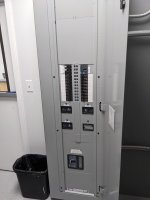Jay M
Member
- Location
- Dallas Texas
- Occupation
- Architect
Hi All, I am feeling a bit defeated at every turn because common sense should prevail but the more I speak with various electricians, the more frustrated I get. I am going to illustrate an electrical riser diagram with desired parts(see Image) and explain the situation. I am not an electrical engineer but with 20+ years of architecture behind me, I have a fairly decent understanding of the NEC, but I am by no means an expert. My electrical engineer friend, seems to think my riser design is good, but the local trades cant seem to wrap their head around the design without choking on a bunch of NEC codes and of course the old "well that's the way we always done it before". Before someone says did you search the forums? to which I will tell you I have and I have read much which leads me to believe my design is fine, but it never hurts to get another opinion. Thank you for your kind helping attitude in advance. 
I am adding an addition to my home. As you can see from the diagram, I have a 200A service meter base that currently feeds the home. Due to the size of the addition, I am going to have to upgrade to 400A in the future. Today, I need to get power to the new Garage Panel, so I can start the finish out in that area of the addition. In the future I plan to add other panels at other floors of the home and then switch to the 400A service. I do not want to switch the service at the moment. Nor do I think I need to. In my design, the New Garage Panel will act as a subpanel of the existing 200A service initially. In the final configuration, all panels including the existing house panels, will be fed from the 400A service. I want to install the feeders for the New Garage Panel with the proper size today that I will need to use later when I switch to the 400A service. When I switch to the 400A service, I want to connect a new 400A Main Disconnect to a buss gutter and then run sub panels feeders from that bus gutter to the desired subpanel locations. Each subpanel will have a main breaker in it per the rating shown in the diagram. This is where it gets confusing for some reason with every electrician I have spoken with as they seem to think there is some sort of disconnect/breaker problem, but I dont see this. Based on the forums I have read on sub panel questions, my design should be completely allowed by the code. My electrical engineer ran the loads and we are around 320A total load at final build out.
I am hoping to understand where the NEC trips this up and how to work around it.
Thank you in advance and apologies for the long winded post.

I am adding an addition to my home. As you can see from the diagram, I have a 200A service meter base that currently feeds the home. Due to the size of the addition, I am going to have to upgrade to 400A in the future. Today, I need to get power to the new Garage Panel, so I can start the finish out in that area of the addition. In the future I plan to add other panels at other floors of the home and then switch to the 400A service. I do not want to switch the service at the moment. Nor do I think I need to. In my design, the New Garage Panel will act as a subpanel of the existing 200A service initially. In the final configuration, all panels including the existing house panels, will be fed from the 400A service. I want to install the feeders for the New Garage Panel with the proper size today that I will need to use later when I switch to the 400A service. When I switch to the 400A service, I want to connect a new 400A Main Disconnect to a buss gutter and then run sub panels feeders from that bus gutter to the desired subpanel locations. Each subpanel will have a main breaker in it per the rating shown in the diagram. This is where it gets confusing for some reason with every electrician I have spoken with as they seem to think there is some sort of disconnect/breaker problem, but I dont see this. Based on the forums I have read on sub panel questions, my design should be completely allowed by the code. My electrical engineer ran the loads and we are around 320A total load at final build out.
I am hoping to understand where the NEC trips this up and how to work around it.
Thank you in advance and apologies for the long winded post.




